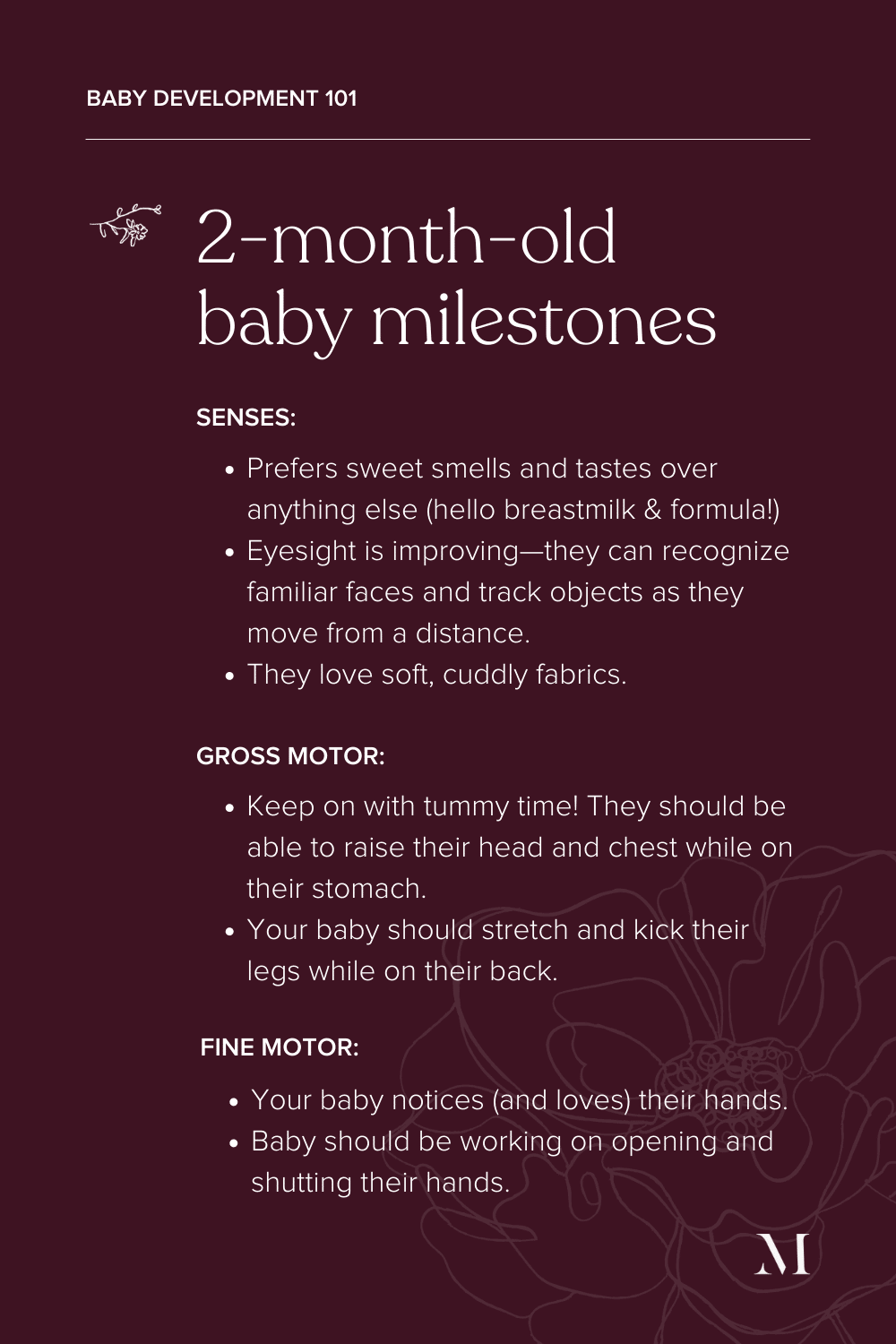2-month-old baby milestones
Your 2-month-old may be working on opening and shutting their hands—and might soon be able to hold and shake toys like a rattle.

We independently select and share the products we love—and may receive a commission if you choose to buy.
Your 2-month-old baby may seem like they are “waking up” more every day—which hopefully translates to some extra sleep at night, too (for everyone involved). Between all that eating and sleeping, it might feel like your baby’s other big focus is on hitting some major developmental milestones—like smiling! They truly are learning in their sleep.
Although it’s probably hard for you to imagine life before your baby came into the world, the truth is you’re still in the newborn phase, and still getting to know each other. That’s why it can be helpful to have a baseline understanding of a 2-month-old baby’s milestones—then you can track progress and consult with your pediatrician if you have any questions or concerns.
2-month milestones at a glance
Just like you’re getting more familiar with your little one, they’re becoming more able to recognize you as well. Baby this month can now look at your face, and may soon start to calm down when they’re picked up or spoken to. As your baby works on fine-tuning their senses and building their strength, you will probably also be treated to another magical milestone soon: Their first smile (most likely when they’re looking at you, mama!).
Related: What happens to a mom’s brain the first time their baby smiles
An in-depth look at 2-month milestones
From improved eyesight to a new discovery of their hands, learn more about what you can expect from your 2-month-old this month.
2-month developmental milestones
Here’s what The Centers for Disease Control and Prevention (CDC) and The American Academy of Pediatrics (AAP) say about 2-month-old baby milestones.
(Editor’s note: The 2-month milestone guidelines were written to reflect the behaviors that 75% or more of children exhibit at a certain age. Note that milestones are not a perfect metric: It’s key to speak to your pediatrician if you have concerns about your unique child.)
Senses
- Two-month-old babies prefer sweet smells and tastes over anything else. And it’s no coincidence that breast milk and formula fits the bill!
- With improving eyesight, your 2-month-old baby can recognize familiar faces and may be able to track objects as they move from a distance.
- Two-month-olds love soft, cuddly fabrics. (But, remember, they cannot have any extra blankets, lovies or stuffed animals in their sleeping space.)
Related: Trying to keep track of baby’s sleep and feeds? There’s an app for that
Gross motor skills
- Keep up with tummy time during awake windows: Your 2-month-old should be able to raise their head while on their stomach.
- Unlike when they were born and preferred to keep their legs pulled up, your baby should stretch and kick their legs while on their back.
Fine motor skills
- Your 2-month-old should be working on opening and shutting their hands—and might soon be able to hold and shake toys like a rattle.
- Your baby notices (and loves) their hands. With more control over their hands, your baby might try to bring their hand to their mouth.
Related: A parent’s guide to car seat safety: Tips, rules & product picks

Baby’s sleep at 2 months
Though your newborn may have somewhat wider wake windows (periods of being awake in between naps) during the day, it’s likely that they’re still sleeping for what feels like a lot of time. Naps are becoming more pronounced, though they’ll still vary a bit in terms of schedule and duration at this time, shares Rachel Mitchell, certified baby sleep consultant and founder of My Sweet Sleeper. You might be getting some longer stretches of sleep at night now that baby’s getting a tiny bit bigger, too.
Your 2-month-old baby should still be aiming for 12 to 16 hours of sleep per 24 hours, according to the American Academy of Sleep Medicine.
Related: Wondering if your baby will ever sleep on a regular schedule? They will—and here’s how you can help
What baby sleep looks like at 2 months:
- Your baby may be taking 3 to 5 naps per day
- Your baby may be sleeping in 2- to 4-hour windows at night
- Your baby may be awake for 30 minutes to 60 minutes at a time
Read more: How much sleep does an eight-week-old baby need?
Feeding a 2-month-old
Your baby is growing so fast, which means they’re likely able to take in a bit more at each feeding now, too, both as their tiny tummy gets larger and as they get more efficient at eating. (They may even be sizing up in onesies!) At 2 months, you should still be following the AAP-recommended responsive feeding method, where you respond to baby’s hunger cues to feed on demand. No strict schedules just yet.
Related: Ice for mastitis? New breastfeeding change everything we thought we knew
The AAP and La Leche League (LLL) recommend the following feeding timeline and amounts for 8-week-olds:
- Breast milk: 4 to 5 ounces every 3 to 4 hours
- Formula: 4 to 5 ounces every 4 hours
Note that these recommendations apply to infants born full-term and without any underlying medical conditions. For preterm infants, babies with certain medical conditions or for any specific feeding questions, be sure to consult your child’s pediatrician. They can help you create a more customized feeding schedule.
Read more: Eight-week-old baby feeding schedules and amounts
Activities for a 2-month-old
You’re maybe starting to come out of the hazy days of the first month with a newborn, and you might start to see the general sketch of a daily schedule start to form, complete with storytime and playtime woven into your little one’s eating and sleeping routines.
Here are a few other activities for a 2-month-old baby to try:
Test out new textures: Help your little one explore their surroundings by introducing them to new textures, like a pet’s fur, a crinkly toy or the leaves of a pretty plant.
Mirror play: Your baby loves looking at your face—and will soon be able to recognize their own. By setting a mirror out on front of their playmat at tummy time or tacking on a few minutes to make silly faces in the mirror after a diaper change, you’re adding an extra layer of entertainment into what could be seen as a humdrum task.
Start talking: Outside of reading aloud, talking to baby, singing and narrating your actions here and there are all ways to help your tot start to understand language and intonation.
Supporting your 2-month-old baby’s development
Ready to make the most of those wake windows? These 2-month-old baby activities can support your cutie’s development.
- Soothe your 2-month-old baby by wearing them in a baby carrier while you walk around the neighborhood. Bonus points for talking to your baby about what you see and hear!
- Play with your 2-month-old baby by reading high-contrast picture books with them.
- Engage your 2-month-old baby’s senses by giving them lots of opportunities for tummy time on a firm surface. A good play gym can make it more exciting for them!
Related: First-time mamas reach milestones too—right alongside their babies
It’s science: Why your baby stops crying when you stand up
When your 2-month-old baby is crying, it feels nearly instinctual to stand up to rock, sway and soothe them. That’s because standing up to calm babies is instinctual—driven by centuries of positive feedback from calmed babies, researchers have found. Equally amazing? Researchers have found that a 5-minute walk-sit routine helps babies stop crying and fall asleep faster, likely due to a similar effect between standing and walking. That feeling of being on the move is so soothing.
A note from Motherly: 2-month milestones
Make no mistake about it, mama: You and your 2-month-old are learning, growing and developing together—and that will be the case for a long time to come. While your baby’s milestones and development might be the most noticeable, they are accomplishing everything with your love and support. Keep it coming!
Look ahead: 3-month-old baby milestones
A version of this story was originally published on Oct. 16, 2021. It has been updated.